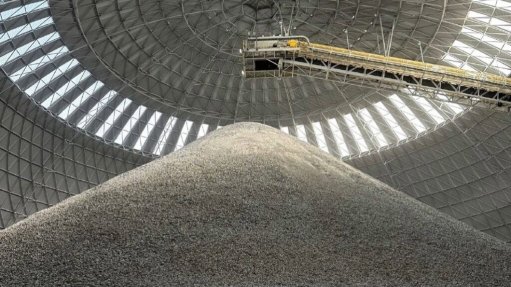Kumba providing helping hand to up-and-coming BEE iron-ore juniors

Kumba Iron Ore CEO Norman Mbazima tells Mining Weekly Online's Martin Creamer that the Anglo American group company, which is heading for steady-state output of some 50-million tons of iron-ore a year, sees it as an obligation to lend a helping hand to emerging black iron-ore juniors. Video: Darlene Creamer
JOHANNESBURG (miningweekly.com) – South Africa’s biggest iron-ore mining company, Anglo American’s JSE-listed Kumba Iron Ore, is lending a helping hand to up-and-coming black economically empowered (BEE) iron-ore juniors in the Northern Cape and Limpopo provinces.
Kumba CEO Norman Mbazima said on Tuesday that the company regarded helping emerging black iron-ore juniors to success as an obligation.
He was responding to a question put by Standard Bank mining analyst Tim Clark at Kumba's presentation of half-year (HI) results, which saw the company dish out another R5-billion to shareholders in an interim dividend pay-out after its operations generated R16.3-billion H1 cash flow.
Profit in the six months to June 30 was R8.6-billion.
“We do quite a lot to try and help BEE iron-ore juniors to optimise their businesses,” Mbazima said, citing as examples giving black juniors access to the company’s efficient rail loading facilities, providing technical mining and grading support and dispensing marketing reinforcement.
Both at Sishen and Kolomela, BEE juniors were permitted to bring their tonnages to Kumba sidings for loading on to trains.
“These are small tonnages and don’t make a big difference to our results,” said Mbazima, who took over as Kumba CEO in September 2012.
But making use of Kumba’s facilities was significantly more efficient than juniors making use of front-end loaders to load their ore on to trains.
“We also provide some technical assistance in mining, grade control and marketing,” Mbazima, 56, who began his working life as a capital accountant at Nchanga Consolidated Copper Mines in Zambia, told Mining Weekly Online.
On the labour front, Kumba is the largest private-sector employer in the Northern Cape with more than 13 000 employees, where it has its flagship Sishen mine and powerfully performing newcomer, the Kolomela operation.
Its smaller Thabazimbi iron-ore mine in Limpopo is being reconfigured as a low-cost, long-life operation and the group as a whole is heading for a total yearly output from all three operations of some 50-million tons of iron-ore a year from 2016.
The market has been tough in the six months to June 30 with prices falling through the floor to $93/t but Kumba managed to improve output in a market dominated by Australian iron-ore expansions, which lifted Australian exports by 25% compared with Brazil’s 8% and South Africa’s 3%.
Massive volumes of overburden are being removed from the Sishen openpit to expose additional ore for mining at a ongoing rate of 37-million tons of iron-ore a year and Kolomela is being primed to produce at a rate of ten-million tons for the next 14 years.
Kumba is setting out to harness all the remaining sources of ore, especially the lower-grade ore, including those at the Phoenix project near the Thabazimbi mine.
The company is continuing to mine out the last of the Thabazimbi resource, which is set to produce at a rate of one-million tons this year.
It has a target to squeeze out an additional five-million tons at the three operations by not only using jig technology but also introducing ultra-high dense-media separation (UHDMS) technology to recover iron-ore from discard material.
The plan is also to debottleneck Kolomela before embarking on another brownfield expansion there and also using UHDMS to capture low-grade opportunities at Thabazimbi.
Kumba's operational profit fell 14% in the six months to June 30 on lower exports and the cost of increased mining activities.
But revenue was up mainly on currency weakness and the company's R15.61 a share interim dividend declaration was maintained because high dividend yield is its biggest investment case.
Revenue of R26.4-billion was marginally higher than the R26.3-billion for the comparable period in 2013, mainly as a result of the 16% decline in the rand/dollar exchange rate, 2% higher total sales volumes and R556-million higher shipping revenue, largely offset by 17% lower average realised export iron-ore prices.
Steel fundamentals remain under pressure as growth in the Chinese economy slows, in particular in the construction markets where concerns remain over housing prices.
Global seaborne iron-ore supply has grown strongly, driven by Australia exporting 25% more and Brazil 8% more.
Iron-ore prices are expected to remain at the current levels of $93/t in the third quarter of the year.
Kumba’s production was up 5% to 22.7-million tons, made up of 15% more lump ore and 9% fewer fines, but exports were 2% down.
Lump premiums, often enjoyed by Kumba because of its high-quality ore, are expected to increase and approach the marginal cost of sintering in the second half of the year.
Strong supply of iron-ore, particularly from Australia, had pushed average iron-ore prices down 19% to $111/t in H1, with the iron-ore index prices ending at $93/t.
Because of increased domestic sales, total sales volumes increased by 2% to 22.5-million tons.
H1 tons mined rose 6% to 154.2-million tons and production rose 5% to 22.8-million tons.
The comprehensive technical studies have confirmed that on average Sishen will produce 37-million tons a year for the remainder of its life following the step-up in the removal of waste to 270-million tons a year in 2016.
H1 waste removed at Sishen mine rose 6% to 86.9-million tons, with the revised mining plan resulting in improved flexibility and better utilisation of equipment.
From next month, Sishen will begin implementing a business process framework to improve productivity.
A stable labour environment is expected to result in the conclusion of a multi-year wage agreement.
Kolomela’s production of 5.5-million tons is up 4% and reconfiguration is planned at Thabazimbi mine to capture low-grade opportunities and increase production to two-million tons a year.
Waste mined at Thabazimbi has increased 18% andthe mine is expected to produce one-million tons of iron-ore this year.
Increased Chinese imports of iron-ore displaced some of the high cost domestic material.
Globally, crude steel production increased by 3.5% to 819-million tons for the first half of 2014, with China’s record production of 409-million tons being 5% higher.
In a seasonal pattern, Chinese steel mills drew down iron-ore inventory levels in early 2014, reducing iron-ore demand.
Kumba wants to export five-million more tons a year over the next three to five years, through incremental growth at Sishen and Kolomela, dependent on available railway capacity, and Kumba is continuing to work with State rail enterprise Transnet to determine an optimum solution for incremental expansion of the iron-ore export channel to Saldanha Bay.
Kumba exports iron-ore to customers in a range of geographical locations around the globe including China, Japan, Korea and a number of countries in Europe and the Middle East.
An exploration programme in Liberia under the joint venture with Jonah Capital – which is part of the company’s long-term growth strategy in West Africa – is off the table on the grounds of being uneconomic.
Kumba was involved in arbitration proceedings against La Société des Mines de Fer du Sénégal Oriental (Miferso) and the State of Senegal over the Falémé project but is keeping the seemingly negligible proceeds from that arbitration under wraps.
Sishen is on track to produce 35-million tonnes and mine around 220-million tons of waste.
Kumba expects Kolomela to produce 10-million tons and Thabazimbi should increase production to one-million tons.
This year’s total export sales volumes are likely to be in line with 2013 levels.
A Kumba worker tragically lost his life in April when he fell from a height while doing maintenance work on a crane at Sishen mine.
The construction of the houses, businesses, churches and schools is under way at Dingleton to facilitate the expansion of Sishen to the west.
Unit cash costs at Sishen mine remained flat at R266/t and Kolomela mine incurred unit cash costs of R211/t, a 16% increase.
Kumba’s H1 operating profit margin decreased to 47% compared with the 55% for the same period of last year.
Capital expenditure (capex) of R3.3-billion was incurred, R2.8-billion on stay-in-business (SIB) activities and R643-million on expansion projects.
The group expects total capex for 2014 to be in the range of R7.5-billion to R8.2-billion.
Capex in 2015 and 2016 will include the results of the finalisation of the Sishen fleet plan for the next five years, as well as the construction activities related at Dingleton, where R4.2-billion is to be spent in the next four to six years.
The level of sustainable SIB capex in future is expected to average R1.7-billion a year.
Domestic sales volumes are expected to be 6.25-million tons for the year in line with the supply agreement with ArcelorMittal.
The Department of Mineral Resources has still not re-awarded the 21.4% mining right to the Sishen Iron Ore Company, which was applied for following the Constitutional Court judgement on the matter in December last year.
The South African tax authorities are also in the process of reviewing certain of the group’s tax matters, which the board contends have been appropriately treated.
Comments
Press Office
Announcements
What's On
Subscribe to improve your user experience...
Option 1 (equivalent of R125 a month):
Receive a weekly copy of Creamer Media's Engineering News & Mining Weekly magazine
(print copy for those in South Africa and e-magazine for those outside of South Africa)
Receive daily email newsletters
Access to full search results
Access archive of magazine back copies
Access to Projects in Progress
Access to ONE Research Report of your choice in PDF format
Option 2 (equivalent of R375 a month):
All benefits from Option 1
PLUS
Access to Creamer Media's Research Channel Africa for ALL Research Reports, in PDF format, on various industrial and mining sectors
including Electricity; Water; Energy Transition; Hydrogen; Roads, Rail and Ports; Coal; Gold; Platinum; Battery Metals; etc.
Already a subscriber?
Forgotten your password?
Receive weekly copy of Creamer Media's Engineering News & Mining Weekly magazine (print copy for those in South Africa and e-magazine for those outside of South Africa)
➕
Recieve daily email newsletters
➕
Access to full search results
➕
Access archive of magazine back copies
➕
Access to Projects in Progress
➕
Access to ONE Research Report of your choice in PDF format
RESEARCH CHANNEL AFRICA
R4500 (equivalent of R375 a month)
SUBSCRIBEAll benefits from Option 1
➕
Access to Creamer Media's Research Channel Africa for ALL Research Reports on various industrial and mining sectors, in PDF format, including on:
Electricity
➕
Water
➕
Energy Transition
➕
Hydrogen
➕
Roads, Rail and Ports
➕
Coal
➕
Gold
➕
Platinum
➕
Battery Metals
➕
etc.
Receive all benefits from Option 1 or Option 2 delivered to numerous people at your company
➕
Multiple User names and Passwords for simultaneous log-ins
➕
Intranet integration access to all in your organisation



















